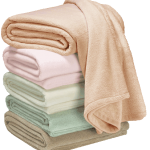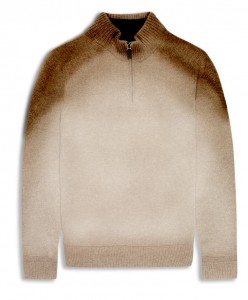Blankets
Warmer Weave, Incorporated is developing blankets that give the user improved warmth in their outer extremities. The blanket is lightweight and provides unparalleled comfort; in fact, the blanket has less weight than two standard blankets. The blanket performs the function of and obviates the need for extra blankets.
Using fewer blankets offers significant cost savings to hospitals, hotels and others with large volume blanket needs.
In the United States there are roughly 4,926,543 guest rooms in hotels that replace blankets two to three times a year. If the total number of guest rooms is assumed to be equally split between single king beds or two queens, the total number of beds, and similarly the total number of blankets, is roughly 7,389,815. This does not include extra blankets stowed in rooms and storage.
If hotels take a minimalistic approach to blanket replacement, for example replacing blankets only twice a year, a total of 14,779,630 blankets would be needed annually.
Hospitals beds in the United States total roughly 920,829, with a replacement schedule of three blankets a year results in a need of 2,762,487 blankets. This analysis does not consider backup supplies or blankets for emergency rooms.
In another example, there are roughly 132,802,859 residential homes and apartments in the United States. If it’s estimated each household has four blankets, the total blankets would total 531,211,436. If each household buys one blanket every other year, another 66,401,430 blankets are needed.
RECAP—U.S. Blanket Market
14,779,630 Hotel & Lodging Association
2,762,487 Hospital Association
66,401,430 U.S. Census Bureau 2013
83,943,547 Min. Est. Blanket Market
Population in United States exceeds 320M and 7.2B in the world. The U.S. and world population use a blanket of some type. Warmer Weave’s blankets manufactured with insulated graduation will allow one blanket to take the place of two or more, in instances where extra blankets are used to keep lower or outer extremities warm while resting, sleeping or simply relaxing. Warmer Weave’s graduated weave technology is far more comfortable, lightweight and less expensive than extra blankets, garments, etc.
Using Warmer Weave’s graduated woven materials, textiles can be manufactured in the form of:
• Military Blankets
• Sleeping Bags
• Comforters
• Bed Linens
• Rescue/Emergency Blankets
Gloves, Mittens and Glove Linings
Manufacturing gloves, mittens and glove linings that provide greater warmth at the fingertips provides greater warmth and comfort to the user. This is accomplished by graduating higher insulated fibers or yarns toward the fingertips. This will reduce palm sweat, and increase comfort, dexterity and wearability in cold conditions. The current practice uses a single yarn type or a lining of one fabric type. Warmer Weave’s knitted fabric graduates higher insulated threads into the fingertip area with less graduation toward the palms. Warmer Weave’s fabrics for use with gloves, mittens and linings can be constructed with various fibers such as Thinsulate™ in conjunction with polyester or other types of synthetic or natural fibers.
Socks
Manufacturing socks that favor warmth at the toes give greater comfort and warmth to the wearer. This is accomplished by graduating higher insulated fibers or yarns toward the toes. Warmer Weave’s graduated fabrics reduce foot sweat in “hotspots”, and increase comfort and warmth in cold spots. The current practice is the use of one type of yarn or a lining constructed from one type of fabric. Warmer Weave’s fabrics graduate higher insulated threads toward the toes and less toward the heel of the foot. Warmer Weave’s fabrics for use with socks can be constructed with various fibers such as Thinsulate™ in conjunction with polyester or other types of synthetic or natural fibers.
Shirts and Blouses
Currently most shirts and blouses are manufactured using one type of fabric. Using interwoven graduated fabrics provides greater comfort to the wearer by minimizing the well-known “hot-and-cold” zones in clothing and apparel. For example, arms, shoulders, sides and other affected areas become cold during rest or stress while the body’s core and underarm area remains relatively warm. Using Warmer Weave’s graduated woven fabrics, greater insulating factors, warmth and comfort are graduated into these areas providing the wearer with a natural, equally distributed feeling of warmth and comfort. Warmer Weave’s fabrics for use with shirts and blouses can be constructed with various fibers such as Thinsulate™ in conjunction with polyester or other types of synthetic or natural fibers.
Slacks and Pants
Currently most pants and slacks are manufactured using one type of fabric. Using interwoven graduated fabrics provides greater comfort to the wearer by minimizing the well-known “hot-and-cold” zones in clothing and apparel. For example, an individual’s crotch area is often warm during normal activity and uncomfortably warm during hi activity, such as while sporting. Using Warmer Weave’s graduate woven fabrics, greater insulating factors, warmth and comfort are graduated into these areas providing the wearer with a natural, equally distributed feeling of warmth and comfort in the thigh and lower leg area. Warmer Weave’s fabrics for use with slacks and pants can be constructed with various fibers such as Thinsulate™ in conjunction with polyester or other types of synthetic or natural fibers.
Clothing that requires protective areas often needs added insulation. Warmer Weave’s graduated woven fabrics can provide areas in apparel with graduated protective properties, such as undergarments or outer apparel with more/less insulated fabrics around protected areas of the body. Examples of protective wear that will benefit from Warmer Weave’s graduated woven fabrics can include, for example:
• Chef’s Uniforms
• Combat Uniforms
• Police Uniforms
• Construction Uniforms
Sporting Apparel
High tech microfibers and fabrics have been developed and are gaining significant market share given that they are light weight and comfort. Despite their popularity, the materials still have many drawbacks given that they are manufactured from a single type of material; and, in the case where more than one material is used they are not graduated to account for the graduated insulatory needs of the body. Warmer Weave’s graduated materials can address the “hot-and-cold” zones in sporting apparel by graduating fabric properties.
Companies such as Head®, Nike®, Under Armour®and Lululemon Athletica® have name recognition and compete for market share for sporting apparel. The current trend in sporting apparel is to tailor clothing to one’s personalized comfort, specifically targeting comfort through personalized fitness gear.
Cabela’s® has introduced Thermal Zone sportswear that combines three weights of Polartec® fabric into one garment. This is a new trend that is being developed using several types of materials sewn together to make an individual garment more comfortable. While this supports the trend for the development of thermo-zoned clothing it is patchwork whereas the material Warmer Weave, Inc. is developing has varying thermal properties using a unique weaving process that allows for greater comfort with one seamless fabric.
With this trend towards high tech fabrics, Warmer Weave’s graduated fabrics are strategically positioned to further develop existing company products targeting individual comfort zones and minimizing high perspiration areas with gradual weaves and knits using high tech fabrics as well as conventional natural fabrics.
Intellectual Portfolio
Warmer Weave has issued patents domestically and abroad, including protection in the majority of populated areas in most industrial countries. Countries that are known for manufacturing clothes and materials for the garment industry were specifically considered and targeted in the Warmer Weave’s intellectual property protection strategy. Climate was also a factor heavily considered, including:

• Moist Mid-Latitude Climates
• Moist Mid-Latitude Climates with Mild Winters
• Moist Mid-Latitude Climates with Cold Winters

